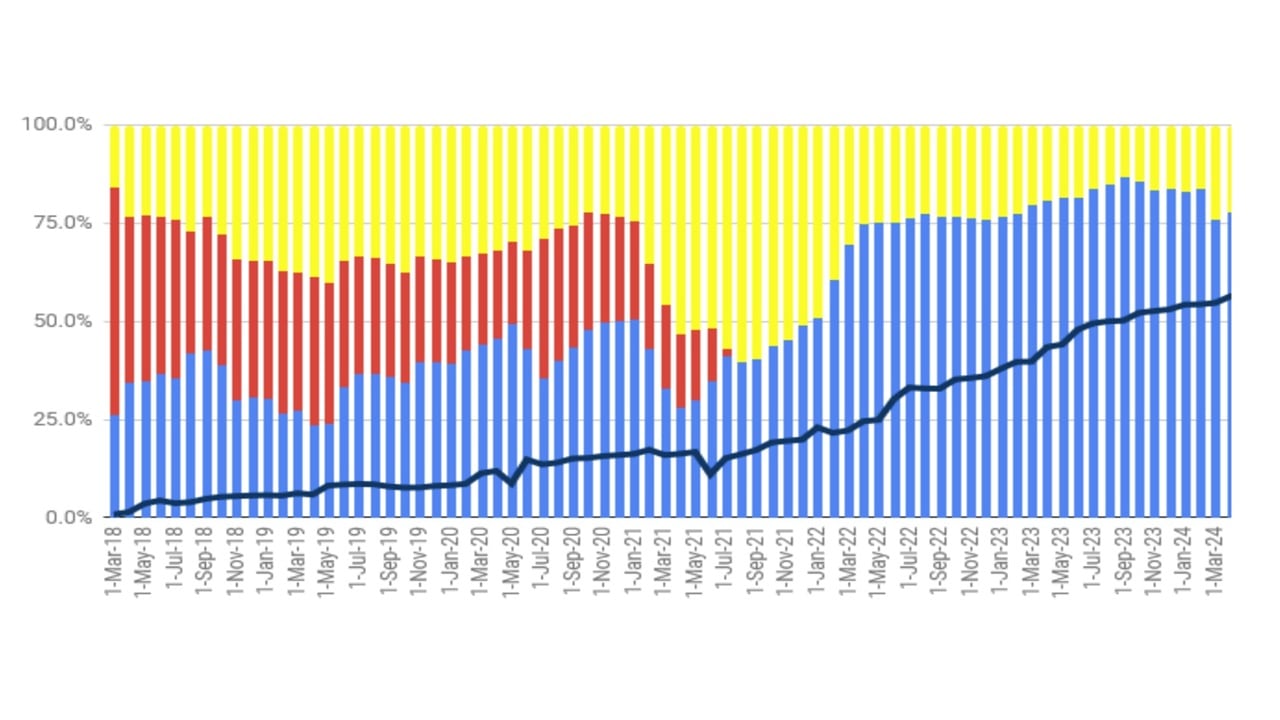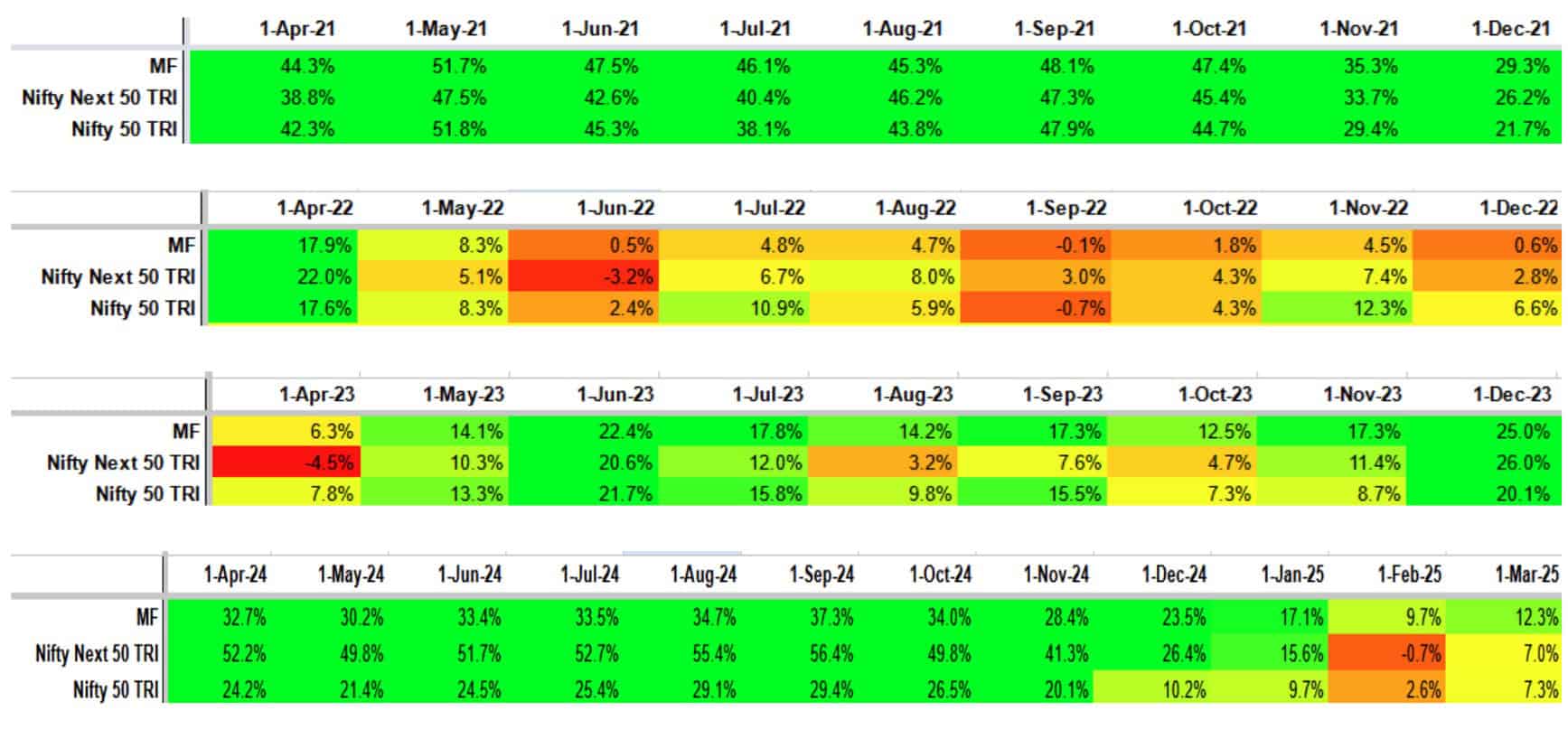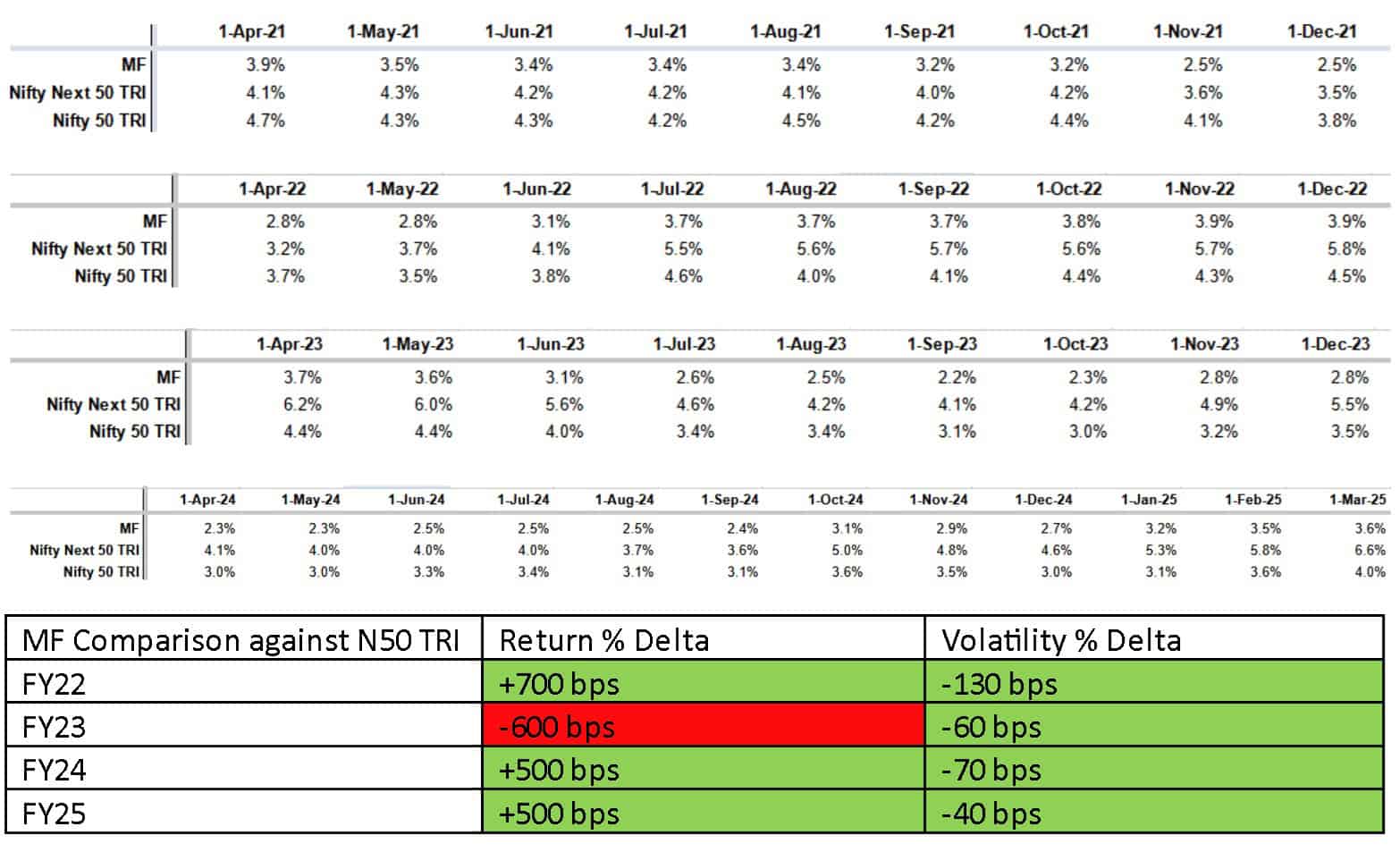This is the third in the series of my finance audits. Focus is again on how I track my personal finance related metrics. This should be helpful for DIY investors and should help them to focus on what and how to measure. I am using the same format and adding a FY25 v/s FY24 section.
- How Sahil plans to achieve financial independence by efficient tracking
- How Sahil achieved a 10X retirement corpus by efficient portfolio tracking
This time I am going directly with the numbers and fewer explanations. Pls read the previous audits to understand the phrases which I have mentioned.
How much do you earn, spend and invest?
- Income growth and investment/expenses
- I am using a dated graph as I don’t want to share the latest numbers, but the following insights are based on real numbers
- Black line shows my 12-month moving average post-tax salary* for any respective month (scale on vertical right axis, redacted to ensure privacy). My salary has grown decently in the last ~5 years and can be seen here in the growth of the black line. Always aim and track if your salary* is increasing at 15%+ rate
- Over the last 12-24 months, I have been able to invest 70-75% (blue) and the remaining 20-25% (yellow) is expenses. No EMIs (red). In the last year, income has continued to increase, albeit at a slower pace, while expenses % are in control
*Pls note that I add EPF contribution (both employer + employee contribution) + NPS employer contribution in salary, although it doesn’t hit my bank account. This overstates by salary and investment ,% but I see no point in not including EPF+NPS contributions

Asset Allocation and Where to Invest?
Join 32,000+ readers and get free money management solutions delivered to your inbox! Subscribe to get posts via email! (Link takes you to our email sign-up form)
🔥Want to create a complete financial plan? Learn goal-based investing? Exclusive access to our DIY tools? Increase your income with your skills? Use this link to enjoy massive discounts on our robo-advisory tool & courses! 🔥
- I don’t maintain a separate emergency fund and have a unified portfolio. It is easier for me to calibrate and measure. Again, one insight here is it becomes extremely difficult to increase the equity exposure as you literally must pour all money in equity irrespective of valuation, where I have some reservations and hence increase in equity% has slowed down. I invested 67% of my cash salary in equity and that resulted only in a 4% increase in equity%
My avg. asset allocation as in FY25 vs avg. asset allocation in FY24 is as follows. I am happy with the increase in equity and reduction in Debt MFs and Liquid Debt
- Savings and FD: ~7% v/s 8% (Target: 5%)
- Debt MFs: ~15% v/s 15% (Target: 10%)
- Debt Illiquid (PPF + EPF + NPS-C/G): ~22% v/s 25% (Target: 15%)
- Equity (MFs+ Stocks+ NPS-E): ~45% v/s 41% (Target: 50%)
- Gold (SGB): ~6% v/s 4% (Target: 10%)
- REIT: ~6% v/s 6% (Target: 10%)
- Here is a bit more information on the instruments used:
- Debt MFs are mix of short term (liquid/arbitrage/UST/Savings) and some medium-term/TMF Debt/Gilt MFs. ~67% is arbitrage plus liquid funds (for rebalancing and emergency use cases), ~13% is short duration and ~19% are TMF+ Gilt funds for locking yields.
- I ensure that the illiquid part of the portfolio i.e. EPF, PPF, NPS doesn’t become too large (>30-35%) because what use is the money if we can’t take it out during times of need. It has been going down now to ~22% v/s ~40% in FY20
- I have NPS Tier-1. Although it is very nominal value but boy, I love NPS T-1 for rebalancing without tax incidence. I started FY24 with 75% equity exposure. I reduced it to 10% E in Jun’24 and further to 0% E in Oct’24 and increased it to 45% E in Mar’25. Call about timing. I made 16% in FY25 in NPS when NPS-E/C/G/A all delivered <8% in FY25 just by exiting and entering at the right time. I wish NPS T-1 was large amount for me but it can’t be unless employer contributes to it.
- Equity portfolio is majorly driven by MFs (85%+), NPS-E (<5%) & Indian stocks (10%+)
- Target amongst the equity portfolio is to have 80-85% India and 15-20% US + China weight. I added China MF this year. I’m at ~10% US + ~10% China and rest India. China was added when their market started recovering in Sep/Oct’24 and when India felt overvalued
- Target in the India portfolio is to have ~10-15% small cap, ~20-25% mid cap and remaining large/giant cap. Currently, I have ~5% small cap and ~21% mid cap, lower than last year. I under own in small and mid-cap but I don’t feel given current valuations there is a case to increase the %age. Of course, SIP continues but lower number and all lump sum goes in large cap
- MFs- PPFAS Flexi cap, Motilal S&P 500, SBI small cap, Invesco mid cap, Edelweiss Balanced advantage and new entry Axis China. Though I also have some N50 and NN50, I use them only for lump sum. No new Indian fund added in last 36 months
- Stocks: 12 stocks compared to 10 last time. Like of ITC, HDFC Bank, Indigo and a few new age companies. Exited Paytm, Titan. For the first time in the last 4 years, mmy stock portfolio has beaten Equity MF portfolio by 2%+. I will be happy if it happens again next year
- New Gold exposure via ETF + Gold MF (stopped SGB as they are trading at a premium). REIT exposure via four listed REITs. I have been buying fixed amount every month. Gold continues to shine and has been a great return this FY, 35 %+. REIT returns have made a comeback (10%+ return), beating fixed income this tim.e
- I measure the standard deviation and rolling returns of each equity MF and as a basket.
- I have beaten N50 TRI and NN50 TRI handsomely by 5% in FY25, way better than last few years. Part of this attribution goes to diversification due to 20% US and China exposure and good returns by selected MFs.
- Just for clarity and explanation on how to read the table below: My Equity MF portfolio gave 12.3% return from Apr-Mar’24 against ~7% return for Nifty50 TRI
- I have beaten N50 TRI and NN50 TRI handsomely by 5% in FY25, way better than last few years. Part of this attribution goes to diversification due to 20% US and China exposure and good returns by selected MFs.

Here’s the rolling 12-month standard deviation of my equity MF for several months against N50 TRI and NN50 TRI.

I have been able to beat the indices both in return and volatility in FY25, the same as FY24. This is the holy grail with lower volatility than Nifty, getting a higher return. I am super happy with this result. Mind you, this is tough and not attributed to me but to the performance of chosen MFs. Pls note idea is to get lower volatility and not higher return %. But I will take the higher return rate. 😊
- XIRR as of 1st April 2025
- Equity MF: ~18% (This was ~23% last year)
- Debt MF: ~6.7% (Investing since 2017)
- NPS: ~16% (Investing since 2019)
- Gold: ~25% (Investing since 2020)
- REITs: ~9% (Investing since 2021)
- PF: ~8.2% (Don’t want to tell you my age :D)
- PPF: ~7.4% (Investing since 2015)
- Money saved: No FnO, No trading, No LIC endowment/ULIP plan.
Net-worth (NW) and its measurement
- All this saving, investment, asset allocation and fund selection is fine but how do you bring it all together.
- An example: NW on 1-Nov-01: 100; Nov-21 salary: 10 and expenses: 6; NW on 1-Dec-01: 105. Now, NW has increased by 5 units in 1 month; 4 units (80%) can be attributed to salary savings and the remaining 1 unit (20%) can be attributed to asset income.
- In FY25, my NW has increased by ~40% and about ~70% growth came through salary savings and the remaining ~30% through asset returns (capital gain + interest etc.).
- In FY24, 60% came from salary and 40% from asset returns. FY25 was not a great year for equity and hence this decrease in asset return contribution
- In FY23, 90% growth had come from salary increase and 10% from asset returns.
- As we become older, most of the growth should come from asset returns which happened in FY24 compared to FY23 but not in FY25. Exceptional years like FY24 with amazing equity returns can give a huge jump to net worth but years like FY25 would be more the norm
- Overall, till date, ~76% of my net worth is from human capital (salary-expenses) and rest ~24% if from financial/asset returns. The latter number was <10% 3 years before
- I’ve crossed 10+ times (I don’t want to share the exact number) of annual expenses in terms of my FIRE goal. I want to reach 30- 40x in the next 10 years.
- I have realised that this corpus doesn’t have much value if you don’t own a home. I don’t own and the prices are so exorbitant that either I buy outright and go to negative net worth, or I pay 40-50% of my income as EMIs thereby reducing investment primarily to EPF as I will have not much cash left after expenses. While the above points make me happy, this one makes me feel a little worried.

Use our Robo-advisory Tool to create a complete financial plan! ⇐More than 3,000 investors and advisors use this! Use the discount code: robo25 for a 20% discount. Plan your retirement (early, normal, before, and after), as well as non-recurring financial goals (such as child education) and recurring financial goals (like holidays and appliance purchases). The tool would help anyone aged 18 to 80 plan for their retirement, as well as six other non-recurring financial goals and four recurring financial goals, with a detailed cash flow summary.
🔥You can also avail massive discounts on our courses and the freefincal investor circle! 🔥& join our community of 8000+ users!
Track your mutual funds and stock investments with this Google Sheet!
We also publish monthly equity mutual funds, debt and hybrid mutual funds, index funds, and ETF screeners, as well as momentum and low-volatility stock screeners.
You can follow our articles on Google News

We have over 1,000 videos on YouTube!

Join our WhatsApp Channel



- Do you have a comment about the above article? Reach out to us on Twitter: @freefincal or @pattufreefincal
- Have a question? Subscribe to our newsletter using the form below.
- Hit 'reply' to any email from us! We do not offer personalised investment advice. We can write a detailed article without mentioning your name if you have a generic question.
Join 32,000+ readers and get free money management solutions delivered to your inbox! Subscribe to get posts via email! (Link takes you to our email sign-up form)
About The Author
 Dr M. Pattabiraman (PhD) is the founder, managing editor and primary author of freefincal. He is an associate professor at the Indian Institute of Technology, Madras. He has over 13 years of experience publishing news analysis, research and financial product development. Connect with him via Twitter(X), LinkedIn, or YouTube. Pattabiraman has co-authored three print books: (1) You can be rich too with goal-based investing (CNBC TV18) for DIY investors. (2) Gamechanger for young earners. (3) Chinchu Gets a Superpower! for kids. He has also written seven other free e-books on various money management topics. He is a patron and co-founder of “Fee-only India,” an organisation promoting unbiased, commission-free, AUM-independent investment advice.
Dr M. Pattabiraman (PhD) is the founder, managing editor and primary author of freefincal. He is an associate professor at the Indian Institute of Technology, Madras. He has over 13 years of experience publishing news analysis, research and financial product development. Connect with him via Twitter(X), LinkedIn, or YouTube. Pattabiraman has co-authored three print books: (1) You can be rich too with goal-based investing (CNBC TV18) for DIY investors. (2) Gamechanger for young earners. (3) Chinchu Gets a Superpower! for kids. He has also written seven other free e-books on various money management topics. He is a patron and co-founder of “Fee-only India,” an organisation promoting unbiased, commission-free, AUM-independent investment advice.Our flagship course! Learn to manage your portfolio like a pro to achieve your goals regardless of market conditions! ⇐ More than 3,500 investors and advisors are part of our exclusive community! Get clarity on how to plan for your goals and achieve the necessary corpus no matter the market condition!! Watch the first lecture for free! One-time payment! No recurring fees! Life-long access to videos! Reduce fear, uncertainty and doubt while investing! Learn how to plan for your goals before and after retirement with confidence.
Increase your income by getting people to pay for your skills! ⇐ More than 800 salaried employees, entrepreneurs and financial advisors are part of our exclusive community! Learn how to get people to pay for your skills! Whether you are a professional or small business owner seeking more clients through online visibility, or a salaried individual looking for a side income or passive income, we will show you how to achieve this by showcasing your skills and building a community that trusts and pays you. (watch 1st lecture for free). One-time payment! No recurring fees! Life-long access to videos!
Our book for kids: “Chinchu Gets a Superpower!” is now available!


Must-read book even for adults! This is something that every parent should teach their kids right from their young age. The importance of money management and decision making based on their wants and needs. Very nicely written in simple terms. - Arun.Buy the book: Chinchu gets a superpower for your child!
How to profit from content writing: Our new ebook is for those interested in getting a side income via content writing. It is available at a 50% discount for Rs. 500 only!
Do you want to check if the market is overvalued or undervalued? Use our market valuation tool (it will work with any index!), or get the Tactical Buy/Sell timing tool!
We publish monthly mutual fund screeners and momentum, low-volatility stock screeners.
About freefincal & its content policy. Freefincal is a News Media organisation dedicated to providing original analysis, reports, reviews and insights on mutual funds, stocks, investing, retirement and personal finance developments. We do so without conflict of interest and bias. Follow us on Google News. Freefincal serves more than three million readers a year (5 million page views) with articles based only on factual information and detailed analysis by its authors. All statements made will be verified with credible and knowledgeable sources before publication. Freefincal does not publish paid articles, promotions, PR, satire or opinions without data. All opinions will be inferences backed by verifiable, reproducible evidence/data. Contact Information: To get in touch, please use our contact form. (Sponsored posts or paid collaborations will not be entertained.)
Connect with us on social media
- Twitter @freefincal
- Subscribe to our YouTube Videos
- Posts feed via Feedburner.
Our publications
You Can Be Rich Too with Goal-Based Investing
 Published by CNBC TV18, this book is designed to help you ask the right questions and find the correct answers. Additionally, it comes with nine online calculators, allowing you to create custom solutions tailored to your lifestyle. Get it now.
Published by CNBC TV18, this book is designed to help you ask the right questions and find the correct answers. Additionally, it comes with nine online calculators, allowing you to create custom solutions tailored to your lifestyle. Get it now.Gamechanger: Forget Startups, Join Corporate & Still Live the Rich Life You Want
 This book is designed for young earners to get their basics right from the start! It will also help you travel to exotic places at a low cost! Get it or gift it to a young earner.
This book is designed for young earners to get their basics right from the start! It will also help you travel to exotic places at a low cost! Get it or gift it to a young earner.Your Ultimate Guide to Travel
 This is an in-depth exploration of vacation planning, including finding affordable flights, budget accommodations, and practical travel tips. It also examines the benefits of travelling slowly, both financially and psychologically, with links to relevant web pages and guidance at every step. Get the PDF for Rs 300 (instant download)
This is an in-depth exploration of vacation planning, including finding affordable flights, budget accommodations, and practical travel tips. It also examines the benefits of travelling slowly, both financially and psychologically, with links to relevant web pages and guidance at every step. Get the PDF for Rs 300 (instant download)